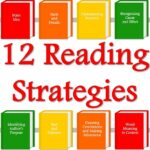4 Comprehension Techniques To Boost Your GPA

1. Mindmapping
In his book Straight-A’s in College While Studying Less, author James Turner shares a handful of techniques that most any student can use to achieve a deeper understanding of any subject. At the top of that list is mindmapping. But not just any kind of mindmapping! Turner shares his thoughts.
“There are two kinds of mindmaps I do. The first is a Big Picture mindmap. When the professor finishes a topic or a theme, I start to draw a mindmap to consolidate every single concept. This does not have to be comprehensive. I normally go at maximum 2 levels deep. All I want to see here is what the breadth of the topic is, and what I am expected to study.
“The second is a Small Details mindmap. This kind of mindmap is far more powerful. Instead of taking a topic title as the main topic, you take one small concept and use mindmapping techniques on it. I am not very good at drawings, but I try to draw something symbolic of the sub-topics next to them. This leaves a more visual imprint in my head.”
2. Building a House, or ‘Brick by Brick’
When building a house, you don’t start with the walls. You pour a foundation. By understanding the fundamentals, in other words, you have the ability to press your understanding and grow as a learner. To make this technique work for you, Turner shares his thoughts.
“This technique can be summed up as: Try to teach the concept to a child. … The first principle would be to start from the foundation, then work your way upwards. You would first find the most basic concepts that are related to the explanation, then slowly introduce more difficult concepts, leading up to the main concept you want to explain. The second principle would be to introduce metaphors to teach a child more effectively. For example, if you are teaching a child about the relationship between demand and supply, you could explain it as such: When there are more people who want to buy ice-cream, there will be more people who are willing to sell ice-cream to make money. When you are teaching yourself, ask yourself – would a child understand what I am teaching? Am I leaving anything out? Are there logic holes in my teaching? Is this too simple or too difficult?”
A wonderful Internet example of this concept brought to life is the reddit sub-thread ELI5, or “Explain to me like I’m a five-year-old.” Quickly browsing through this subreddit you can find a number of enlightening threads, such as, What does the Trans-Pacific Partnership mean for me, and what does it do?” and “What’s the difference between LCD, LED, and PlasmaHDTVs?” This can also be a good spot to begin the journey for the next comprehension technique on our list…
3. Research
When all else fails, consult other materials to help you brush up on the things that you don’t know. Even here, though, Turner has a few suggestions that you should consider.
“Google is indeed my best friend. While websites may not be technically the most reliable places to seek scholar-quality information, you can use them for simple explanations. After that, take it to the textbook for more details. If you are studying something that is very visual, such as a specific metabolic pathway, it could be very helpful to find diagrams or Youtube videos on the subject. It helps a TON! Sometimes, at the back of your textbooks, there might be some kind of learning aid CD. It depends on the textbook, but generally I’ve found that is really helps in explaining concepts well. Always have some form of internet access around with you when you are studying. If your laptop distracts you, then use a more limited form of technology – such as a smartphone in Airplane mode and Wifi enabled.”
In the past, we’ve heard a lot of bad things from teachers about the dangers of Wikipedia. While it’s true that Wikipedia is largely crowd-sourced information, and so there are many things on there that are unreliable, it’s still a great tool to have on your side for two specific reasons: 1) There are a list of references to where the information on the page was derived from, and if there aren’t, then that’s a telltale sign of where your research needs to lead you next because you now have information that hasn’t been confirmed; and 2) For broader subject areas that have a lot of cooks in the kitchen, faulty information is quickly sifted through and corrected, making it far more dynamic and, yes, accurate, than your typical encyclopedia per capita. I would still use scholarly sources when it comes to confirming information, but Wikipedia is a website that shines the way there.
4. ‘Bugging and Debugging’
Again consulting Turner’s excellent look at building your GPA to a 4.0, there are the concepts of deliberate bugging and peer debugging. The writer shares some details on just what he means by this.
First, deliberate bugging: “In this technique, the key question you want to ask is this: ‘What will happen if this did not exist?’ Be specific and detailed when you answer this. You will require an understanding of how the concept or idea comes about — this is how it forces you to understand it. As a very basic example, let’s talk about photosynthesis. What will happen if ‘water’ did not exist? You can then pinpoint it to the various chemical processes that are not able to function when water does not serve its role. From there, you spider-web outwards. Another big way to use this are exceptions. You will ask this question: ‘What does not apply to this?’ In this way, you start to exclude information from what you are understanding and you develop a categorical type of learning.
“Lastly, I like to ask the question: ‘What makes the biggest impact when I remove it?’ Let’s say you are weighing points in an essay. What weakens the argument greatly when you remove it?”
And next, peer debugging: “I normally try to tutor other peers. Why? Because of two things: I can learn from their mistakes and I can refresh my memory on the concepts. When people ask questions, they force you to answer by selectively picking out information. It forces you to apply what you’ve learnt. On top of that, it becomes more conversational and natural. It links the information for you. I also enjoy teaching people on past subjects so that I can retain a memory of these subjects. In my medicine course, for example, I am required to know information from previous modules and units. By tutoring other students in these previous subjects, I can retain memory from them and get an advantage over my peers.”
In Summary
As you advance through the ranks of higher education, you are going to encounter more and more difficult problems and complex information to decipher. Luckily, your brain develops as you go, but as the old saying goes, “If you don’t use it, you lose it.” Understanding techniques like those mentioned in this article can help you use your brain wisely and get the most from the study materials you encounter. What are some comprehension techniques that have worked for you? Anything different from what we’ve presented on this list? Share your thoughts in the comments section below!
[Image via Amazon, linked above]








